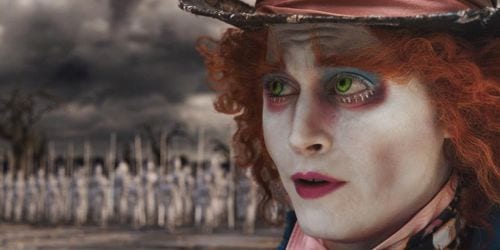
Alice Kingsleigh (Mia Wasikowska) is a very independent girl. Constrained by the gender norms of her Victorian era, she launches her rebellions where she can. Namely, against the marriage her mother Helen (Lindsay Duncan) has arranged, as well as the scolding her mother gives her for not wearing corset or stockings.
Alice in Wonderland thus begins in a land that is not wonderful, but rather, practical and petty. When Alice arrives at the manse of the Lady and Lord Ascot (Geraldine James and Tim Pigott-Smith), her future only looks bleaker. Horrified at being schooled in the gastrointestinal difficulties of her husband-to-be Hamish (Leo Bill) and how she will have to manage them, she prickles. She’s hardly mollified when her sister Margaret (Jemma Powell) tells her, “Your life will be perfect. It’s already decided.”
No wonder Alice retreats routinely into fantasy worlds where she can think and decide for herself. Whether on the dance floor, where she imagines “all the ladies in trousers and the men in dresses,” or down the rabbit hole, she seeks escape from the stultifying propriety all around her. It is in Wonderland that Alice is able to consider who she wants to be and what she wants out of life. Here, she’s asked repeatedly if she is “the” Alice. The Dormouse (voiced by Barbara Windsor) insists that she is “the wrong Alice,” and the Blue Caterpillar (Alan Rickman) suggests that she is “almost” Alice. Only one new acquaintance, the Mad Hatter (Johnny Depp), is firm in his belief that she is precisely “the right Alice.”
The “right” Alice is the Alice of prophecy, who will slay the Jabberwocky (in one of director Tim Burton’s many significant departures from Lewis Carroll’s story), thus ending the reign of the Red Queen (Helena Bonham Carter) and reinstalling the White (Anne Hathaway). It is in relation to this heroic quest that Alice will have to decide for herself whether she is “the” Alice.
The answer to that quandary is in many ways as predetermined as her life back in England. Set down in the middle of a battle between “good” and “evil,” Alice has little real choice in whether she will support the White Queen or the Red Queen. The former is diaphanous and pale, the latter axe-happy, chopping off the heads of all who cross her, however insignificantly. She’s vainglorious and cruel. After one of her frog attendants is separated from his head for poaching her tarts, the Red Queen orders his family rounded up, quipping, “I love tadpoles on toast almost as much as I love caviar.”
In her usurpation of the crown from her White sister and her refusal of the common order of things, the Red Queen represents the kind of independence that Alice might find appealing. But, because she’s evil, Alice’s affiliation must be, inevitably, with the White Queen.
What Alice can’t see is that the White Queen is trapped in the same kinds of gendered social norms that so trouble Alice in her life back in England. Whenever the White Queen is in the presence of her subjects, she floats-prances around with her arms akimbo and palms to the skies and speaks in a breathy, “girly,” sing-songy voice, as a Queen is apparently supposed to behave. When she’s by herself, though, she drops those arms to her sides, clearly exasperated by the role that she is expected to play. The White Queen enlists Alice’s help because she cannot take up the Vorpal Sword and slay the Jabberwocky herself, as it would go against “her vows,” which is to say it would go against the gender proscriptions of queenly femininity.
So the question Alice must answer for herself is whether she will take up the “manly” duty of champion and slay the Jabberwocky. She dithers about it, but we all know she will fulfill her quest. And we know that she will return from Wonderland empowered and self-assertive. And yet it is here that Alice in Wonderland‘s feminist sensibilities fail. For “the right Alice,” independence amounts to taking up her father’s place in patriarchy and capitalism. Her father was a global trader and it is Alice’s ambition to take over his business instead of marrying Hamish. Women’s liberation in Alice in Wonderland, then, amounts not to any structural revolution, but merely assimilation into the ruling order.

![Call for Papers: All Things Reconsidered [MUSIC] May-August 2024](https://www.popmatters.com/wp-content/uploads/2024/04/all-things-reconsidered-call-music-may-2024-720x380.jpg)



